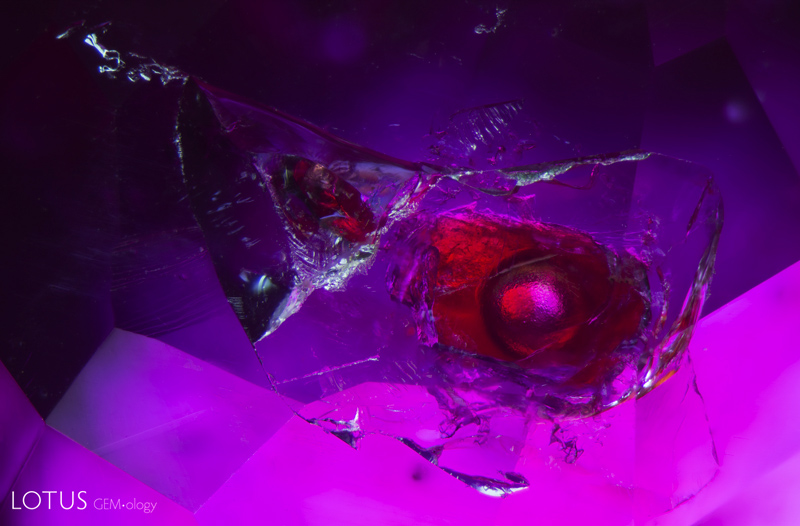A ruby’s surface-reaching cavity is filled with red oil.
 The red color of the oil within the cavity of a ruby displays a remarkable contrast with the bodycolor of the gem. Unlike the flattened bubbles regularly encountered, a rounded bubble attests to the size of the cavity containing the oil.
The red color of the oil within the cavity of a ruby displays a remarkable contrast with the bodycolor of the gem. Unlike the flattened bubbles regularly encountered, a rounded bubble attests to the size of the cavity containing the oil.
Photomicrograph by E. Billie Hughes; field of view approximately 2.5 mm.
As laboratory gemologists working in Bangkok, we often encounter gems that have been treated with oil to minimize the appearance of fissures. Most of these stones come from Myanmar, where many vendors consider oiling an accepted standard procedure to enhance their goods, particularly ruby and spinel. Furthermore, red oil is commonly used not only to improve clarity, but also to enhance the color of the stone (in Chanthaburi, Thailand, it is sold under the brand name “King Ruby Red Oil”). Often this treatment can be identified by flattened gas bubbles in the fissures or by droplets of oil seeping out of the fissures on the surface when the stone is gently warmed by microscope light or hot point.
The image above shows a small surface-reaching cavity filled with oil in an unheated 1.75 ct ruby from Myanmar. Unlike other examples we have seen, this remarkable gem contained enough of the filler to easily photograph the striking red color of the oil itself within the cavity. With oblique fiber-optic lighting, a stunning image of this enhancement in situ was made possible, turning even an otherwise commonplace forensic determination into an aesthetic exploration of the micro-world.
About the Author
E. Billie Hughes visited her first gem mine (in Thailand) at age two and by age four had visited three major sapphire localities in Montana. A 2011 graduate of UCLA, she qualified as a Fellow of the Gemmological Association of Great Britain (FGA) in 2013. An award winning photographer and photomicrographer, she has won prizes in the Nikon Small World and Gem-A competitions, among others. Her writing and images have been featured in books, magazines, and online by Forbes, Vogue, National Geographic, and more. In 2019 the Accredited Gemologists Association awarded her their Gemological Research Grant. Billie is a sought-after lecturer and has spoken around the world to groups including Cartier and Van Cleef & Arpels. In 2020 Van Cleef & Arpels’ L’École School of Jewellery Arts staged exhibitions of her photomicrographs in Paris and Hong Kong.
Notes
This article first appeared in Gems & Gemology, Summer 2017, Vol. 53, No. 2.
